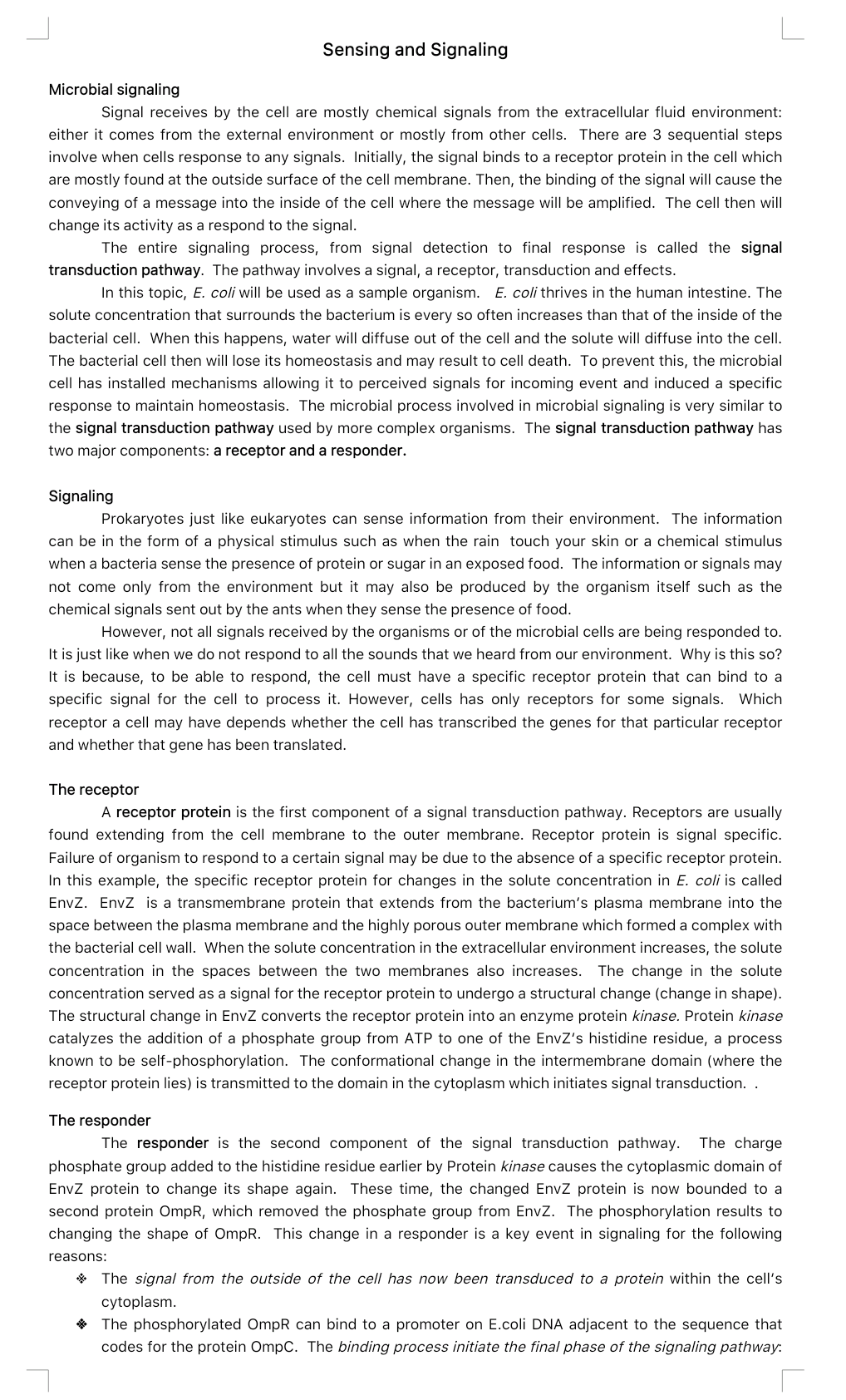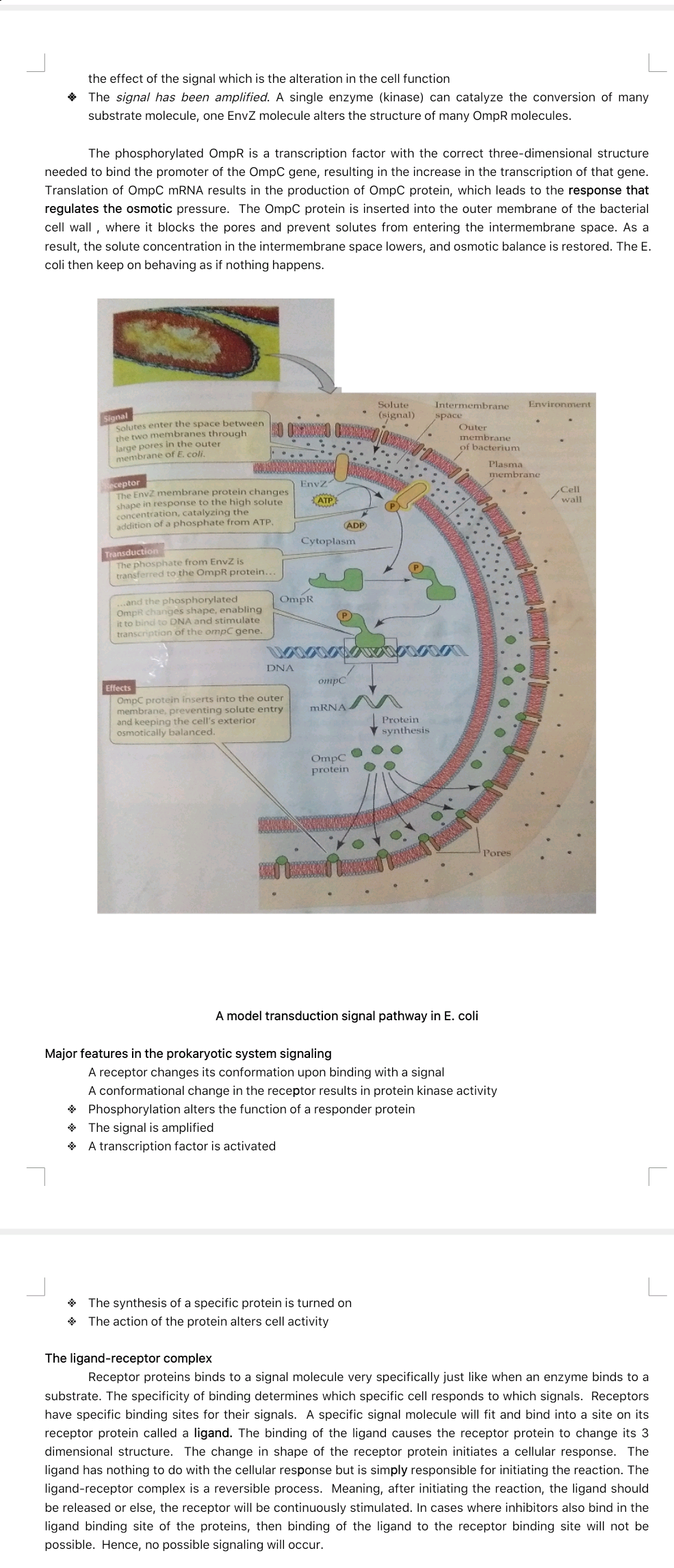QUESTION : How did the bacteria maintain its homeostasis when homeostatic disturbance occur. Explain your answer the way you understand the process of sensing and signalling see pictures below
QUESTION : How did the bacteria maintain its homeostasis when homeostatic disturbance occur. Explain your answer the way you understand the process of sensing and signalling see pictures below
Human Physiology: From Cells to Systems (MindTap Course List)
9th Edition
ISBN:9781285866932
Author:Lauralee Sherwood
Publisher:Lauralee Sherwood
Chapter4: Principles Of Neural And Hormonal Communication
Section: Chapter Questions
Problem 5RE: Second-messenger systems ultimately bring about the desired cell response by inducing a change in...
Related questions
Question
QUESTION : How did the bacteria maintain its homeostasis when homeostatic disturbance occur. Explain your answer the way you understand the process of sensing and signalling see pictures below

Transcribed Image Text:Sensing and Signaling
Microbial signaling
Signal receives by the cell are mostly chemical signals from the extracellular fluid environment:
either it comes from the external environment or mostly from other cells. There are 3 sequential steps
involve when cells response to any signals. Initially, the signal binds to a receptor protein in the cell which
are mostly found at the outside surface of the cell membrane. Then, the binding of the signal will cause the
conveying of a message into the inside of the cell where the message will be amplified. The cell then will
change its activity as a respond to the signal.
The entire signaling process, from signal detection to final response is called the signal
transduction pathway. The pathway involves a signal, a receptor, transduction and effects.
In this topic, E. coli will be used as a sample organism. E. coli thrives in the human intestine. The
solute concentration that surrounds the bacterium is every so often increases than that of the inside of the
bacterial cell. When this happens, water will diffuse out of the cell and the solute will diffuse into the cell.
The bacterial cell then will lose its homeostasis and may result to cell death. To prevent this, the microbial
cell has installed mechanisms allowing it to perceived signals for incoming event and induced a specific
response to maintain homeostasis. The microbial process involved in microbial signaling is very similar to
the signal transduction pathway used by more complex organisms. The signal transduction pathway has
two major components: a receptor and a responder.
Signaling
Prokaryotes just like eukaryotes can sense information from their environment. The information
can be in the form of a physical stimulus such as when the rain touch your skin or a chemical stimulus
when a bacteria sense the presence of protein or sugar in an exposed food. The information or signals may
not come only from the environment but it may also be produced by the organism itself such as the
chemical signals sent out by the ants when they sense the presence of food.
However, not all signals received by the organisms or of the microbial cells are being responded to.
It is just like when we do not respond to all the sounds that we heard from our environment. Why is this so?
It is because, to be able to respond, the cell must have a specific receptor protein that can bind to a
specific signal for the cell to process it. However, cells has only receptors for some signals. Which
receptor a cell may have depends whether the cell has transcribed the genes for that particular receptor
and whether that gene has been translated.
The receptor
A receptor protein is the first component of a signal transduction pathway. Receptors are usually
found extending from the cell membrane to the outer membrane. Receptor protein is signal specific.
Failure of organism to respond to a certain signal may be due to the absence of a specific receptor protein.
In this example, the specific receptor protein for changes in the solute concentration in E. coli is called
EnvZ. Envz is a transmembrane protein that extends from the bacterium's plasma membrane into the
space between the plasma membrane and the highly porous outer membrane which formed a complex with
the bacterial cell wall. When the solute concentration in the extracellular environment increases, the solute
concentration in the spaces between the two membranes also increases.
The change in the solute
concentration served as a signal for the receptor protein to undergo a structural change (change in shape).
The structural change in EnvZ converts the receptor protein into an enzyme protein kinase. Protein kinase
catalyzes the addition of a phosphate group from ATP to one of the EnvZ's histidine residue, a process
known to be self-phosphorylation. The conformational change in the intermembrane domain (where the
receptor protein lies) is transmitted to the domain in the cytoplasm which initiates signal transduction. .
The responder
The responder is the second component of the signal transduction pathway.
The charge
phosphate group added to the histidine residue earlier by Protein kinase causes the cytoplasmic domain of
Envz protein to change its shape again. These time, the changed EnvZ protein is now bounded to a
second protein OmpR, which removed the phosphate group from EnvZ. The phosphorylation results to
changing the shape of OmpR. This change in a responder is a key event in signaling for the following
reasons:
* The signal from the outside of the cell has now been transduced to a protein within the cell's
cytoplasm.
* The phosphorylated OmpR can bind to a promoter on E.coli DNA adjacent to the sequence that
codes for the protein OmpC. The binding process initiate the final phase of the signaling pathway:

Transcribed Image Text:the effect of the signal which is the alteration in the cell function
* The signal has been amplified. A single enzyme (kinase) can catalyze the conversion of many
substrate molecule, one EnvZ molecule alters the structure of many OmpR molecules.
The phosphorylated OmpR is a transcription factor with the correct three-dimensional structure
needed to bind the promoter of the OmpC gene, resulting in the increase in the transcription of that gene.
Translation of OmpC MRNA results in the production of OmpC protein, which leads to the response that
regulates the osmotic pressure. The OmpC protein is inserted into the outer membrane of the bacterial
cell wall , where it blocks the pores and prevent solutes from entering the intermembrane space. As a
result, the solute concentration in the intermembrane space lowers, and osmotic balance is restored. The E.
coli then keep on behaving as if nothing happens.
Solute
Intermembrane
Environment
Signal
Solutes enter the space between
the two membranes through
large pores in the outer
membrane of E. coli.
(signal)
space
Outer
membrane
of bacterium
Plasma
membrane
eceptor
The EnvZ membrane protein changes
shape in response to the high solute
concentration, catalyzing the
addition of a phosphate from ATP.
EnvZ
Cell
wall
LATP
ADP)
Cytoplasm
Transduction
The phosphate from EnvZ is
transferred to the OmpR protein...
...and the phosphorylated
OmpR changes shape, enabling
it to bind to DNA and stimulate
transcription of the ompC gene.
OmpR
DNA
ompC
Effects
OmpC protein inserts into the outer
membrane, preventing solute entry
and keeping the cell's exterior
osmotically balanced.
MRNA
Protein
synthesis
OmpC
protein
Pores
A model transduction signal pathway in E. coli
Major features in the prokaryotic system signaling
A receptor changes its conformation upon binding with a signal
A conformational change in the receptor results in protein kinase activity
* Phosphorylation alters the function of a responder protein
* The signal is amplified
* A transcription factor is activated
* The synthesis of a specific protein is turned on
* The action of the protein alters cell activity
The ligand-receptor complex
Receptor proteins binds to a signal molecule very specifically just like when an enzyme binds to a
substrate. The specificity of binding determines which specific cell responds to which signals. Receptors
have specific binding sites for their signals. A specific signal molecule will fit and bind into a site on its
receptor protein called a ligand. The binding of the ligand causes the receptor protein to change its 3
dimensional structure. The change in shape of the receptor protein initiates a cellular response. The
ligand has nothing to do with the cellular response but is simply responsible for initiating the reaction. The
ligand-receptor complex is a reversible process. Meaning, after initiating the reaction, the ligand should
be released or else, the receptor will be continuously stimulated. In cases where inhibitors also bind in the
ligand binding site of the proteins, then binding of the ligand to the receptor binding site will not be
possible. Hence, no possible signaling will occur.
Expert Solution
This question has been solved!
Explore an expertly crafted, step-by-step solution for a thorough understanding of key concepts.
Step by step
Solved in 2 steps with 1 images

Knowledge Booster
Learn more about
Need a deep-dive on the concept behind this application? Look no further. Learn more about this topic, biology and related others by exploring similar questions and additional content below.Recommended textbooks for you

Human Physiology: From Cells to Systems (MindTap …
Biology
ISBN:
9781285866932
Author:
Lauralee Sherwood
Publisher:
Cengage Learning

Human Physiology: From Cells to Systems (MindTap …
Biology
ISBN:
9781285866932
Author:
Lauralee Sherwood
Publisher:
Cengage Learning